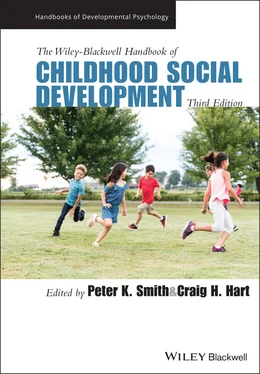The first evidence for an interaction between a latent (estimated rather than measured) genetic risk and measured environmental adversity in the development of antisocial behavior came from an adult adoption study (Cadoret et al., 1995). The authors demonstrated that having an adverse environment, and a genotypic risk (indexed by having a biological parent showing criminality), increased the risk for antisocial outcomes more than would be expected as just an additive effect of both. Jaffee and colleagues (2005) reported a similar finding based on data from a sample of 5‐year‐old twins. They found that maltreatment was only a significant risk for childhood antisocial behavior in the presence of a high genetic risk, as conferred by having a MZ twin with conduct disorder (Jaffee et al., 2005). Molecular genetic studies have also demonstrated G×E: the effect of childhood maltreatment on antisocial behavior was found to be stronger in people with a less active form of the MAOA gene, and this effect is larger for males than females (Byrd & Manuck, 2014; Kim‐Cohen et al., 2006).
Another G×E type refers to the situation when genetic factors amplify a child’s sensitivity to both positive and negative environments. This G×E type is implicated in a differential susceptibility model: children genetically more susceptible to negative influences (e.g., poverty, maltreatment) could also be more susceptible to positive influences (e.g., educational provision, social support) (Belsky & Pluess, 2009). For example, in a study of the DRD4 gene, maternal sensitivity, and behavioral problems in children, it was shown that low maternal sensitivity was associated with behavioral problems, but only in children with the 7R allele of the DRD4 gene. Children with the same gene variant and mother with high sensitivity displayed the lowest level of behavioral problems. For children without the 7R allele of the DRD4 gene, differences in maternal sensitivity had no effect on behavioral problems (Van IJzendoorn & Bakermans‐Kranenburg, 2006).
Another study provided evidence for an interaction between family SES and the serotonin transporter (SLC6A4) gene in relation to juvenile delinquency: a long (more‐active) form of the gene (L‐allele) showed the highest plasticity in boys because of the curvilinear associations between family SES and delinquency. The same pattern was found among girls with a short (less‐active) form of the gene (S‐allele), who also showed curvilinear associations between family SES and delinquency (Åslund et al., 2013). This suggests that the association between SES and delinquency may partly depend on individual genetic differences in sensitivity to environmental influence. Therefore, identification of this type of G×Es would be useful in identifying children with adverse experiences who could also benefit the most from interventions. According to the theoretical framework of vantage sensitivity , people differ significantly in their response to psychological intervention, with some benefitting more from treatment than others, due to individual differences (that are at least partly under genetic influences) in environmental sensitivity, the inherent ability to register, and process external stimuli (de Villiers et al., 2018).
Moreover, it has been shown that specific genetic factors can “suit” some environments better than others (Borinskaya et al., 2009; Chiao & Blizinsky, 2010). For example, it has been found that S‐allele of the serotonin transporter gene is more likely to increase the risk for depression in individualistic rather than in collectivistic cultures (Chiao & Blizinsky, 2010). This and other findings suggest that cultural values may co‐act with genetic factors during evolution. Therefore, children from different populations or cultures can differ in their risk of sociobehavioral problems, and may benefit from different, population‐specific, intervention, and prevention strategies.
To date, only a few genes have been reliably implicated in the modulation of environmental effects on psychopathology. More recently, polygenic scores (as discussed earlier in the chapter) have been studied for their interactions with multiple adverse experiences, in order to gain a better understanding of the role of G×E interaction in risk and resilience pathways. For example, it was found that adolescent parental monitoring and peer substance use moderated polygenic scores for externalizing disorders; genetic effects were more pronounced at low levels of parental monitoring and high levels of peer substance use (Salvatore, Aliev et al., 2015).
Another line of G×E research – epigenomics – has started to uncover molecular mechanisms of co‐action between genetic and environmental influences. An increasing number of studies has demonstrated that various environmental factors (e.g., stress, parenting) can affect gene expression (Meaney, 2010) and, subsequently, child social development (Waltes et al., 2016).
To summarize, genetic variation underlies individual differences in response to various environmental exposures. These differences are stable over time and can help to identify individuals who are at particular risk for developing psychopathology and/or can benefit more from interventions.
Possible Implications of Behavioral Genetic Research
Behavioral genetic studies provide theoretical and practical knowledge for parents, teachers, psychologists, and other professionals working with children. Sociobehavioral problems, such as impulsivity, aggression, and delinquency, are common in children and adolescents (Green et al., 2005). These problems can be serious and, if left unattended, can become persistent and lead to other problems and psychosocial difficulties, such as poor academic performance, impaired social relationships, and socioeconomic difficulties (Fergusson et al., 2005). Therefore, research aimed at increasing our understanding of risk and protective factors, pathways and mechanisms of social development is crucial in aiding the development of effective prevention and intervention strategies for sociobehavioral problems. This knowledge obtained in behavioral genetic research can guide the development of evidence‐based, more focused (e.g., family‐ or person‐oriented) prevention and intervention programs for decreasing the risks of sociobehavioral problems on the basis of individual genetic (or gene–environment) screening (Leve et al., 2010). Because the unique DNA sequence of an individual does not change under the influence of development, behavior, or experience, the information about a child’s genomic profile, including risk and protective genetic factors, could be used for early diagnostics of sociobehavioral problems in order to help with finding the most suitable individualized educational and parenting strategies for all children.
1 Asbury, K., Dunn, J. F., Pike, A., & Plomin, R. (2003). Nonshared environmental influences on individual differences in early behavioral development: A monozygotic twin differences study. Child Development, 74(3), 933–943.
2 Åslund, C., Comasco, E., Nordquist, N., Leppert, J., Oreland, L., & Nilsson, K. W. (2013). Self‐reported family socioeconomic status, the 5‐HTTLPR genotype, and delinquent behavior in a community‐based adolescent population. Aggressive Behavior, 39(1), 52–63.
3 Ball, H. A., Arseneault, L., Taylor, A., Maughan, B., Caspi, A., & Moffitt, T. E. (2008). Genetic and environmental influences on victims, bullies and bully‐victims in childhood. Journal of Child Psychology and Psychiatry, 49(1), 104–112.
4 Barr, P. B., Salvatore, J. E., Wetherill, L., Anokhin, A., Chan, G., Edenberg, H. J., Kuperman, S., Meyers, J., Nurnberger, J., Porjes, B., Schuckit., M., & Dick, D. M. (2020). A family‐based genome wide association study of externalizing behaviors. Behavior Genetics, 50(3), 175–183.
Читать дальше












